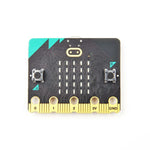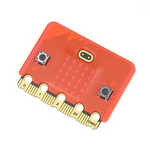The Smart Home Mini-World: Weaving the Magic of Future Homes with micro:bit
It all started with a simple voice-activated light, and then every corner of my house began to get "smart," as if touched by magic.
The first rays of morning sunlight filter through the curtains into the room. I'm not yet awake, but my home has already begun its daily operations. The wardrobe door slides open gently, displaying today's recommended outfit combinations; the temperature-controlled fan in the kitchen adjusts its speed based on the indoor temperature; even the water in the fish tank circulates and refreshes automatically—none of this is a scene from a sci-fi movie but rather the smart life I've achieved using the micro:bit smart home kit.
Chapter 1: The Beginning—The First Dialogue Between Sound and Light
It all began on a rainy weekend. I opened the smart home kit, looked at those small sensors and modules, and decided to start with the simplest project: the Voice-Activated Light.
1 let noise = 0 2 let light2 = 0 3 led.enable(false) 4 basic.forever(function () { 5 light2 = smarthome.ReadLightIntensity(AnalogPin.P3) 6 if (light2 < 50) { 7 noise = smarthome.ReadNoise(AnalogPin.P2) 8 if (noise > 70) { 9 neopixel.create(DigitalPin.P1, 1, NeoPixelMode.RGB).showColor(neopixel.colors(NeoPixelColors.White)) 10 basic.pause(10000) 11 neopixel.create(DigitalPin.P1, 1, NeoPixelMode.RGB).showColor(neopixel.colors(NeoPixelColors.Black)) 12 } 13 } 14 })
This simple code holds wondrous possibilities. The light sensor continuously monitors the ambient brightness. When it detects insufficient light (less than 50 units), the system enters "standby mode." If a sound exceeding 70 decibels—like a clap—is detected, the LED light turns on and automatically switches off after 10 seconds.
During the first test, I deliberately closed the curtains to darken the room and then clapped my hands gently. Instantly, the LED emitted a soft white light, illuminating a small area around it. The feeling of conversing with the house was mesmerizing: I issued a command, and it responded. We had built a magical bond of understanding.
Chapter 2: Temperature Wisdom—Teaching the Fan to Think
The success of the voice-activated light greatly encouraged me, and I decided to take on a more complex project: the Smart Temperature-Controlled Fan.
Summer heat is often unbearable, but running the fan all day is wasteful. I wanted to create a fan system that could sense temperature and adjust automatically.
1 let temp = 0 2 OLED.init(128, 64) 3 basic.forever(function () { 4 temp = smarthome.ReadTemperature(TMP36Type.TMP36_temperature_C, AnalogPin.P1) 5 OLED.clear() 6 OLED.writeString("Temperature:") 7 OLED.writeNum(temp) 8 if (temp > 30) { 9 music.startMelody(music.builtInMelody(Melodies.BaDing), MelodyOptions.Once) 10 pins.digitalWritePin(DigitalPin.P2, 1) 11 basic.pause(5000) 12 pins.digitalWritePin(DigitalPin.P2, 0) 13 basic.pause(500) 14 } else { 15 pins.digitalWritePin(DigitalPin.P2, 0) 16 } 17 })
The way this system works is astonishing: the TMP36 temperature sensor continuously monitors the ambient temperature and displays it in real-time on the OLED screen. When the temperature exceeds 30°C, the system not only emits an alert sound but also automatically activates the fan, running for 5 seconds before stopping for half a second, then continuing to monitor the temperature. If the temperature has already dropped to a reasonable range, the fan remains off.
I will always remember that first hot afternoon when the indoor temperature gradually rose to 30°C, and the fan suddenly started spinning on its own, bringing gusts of cool breeze. At that moment, I felt the tangible comfort brought by technology.
Chapter 3: Smart Furniture—Giving Life to Furniture
As I became more familiar with the smart home kit, I turned my attention to making furniture smarter. My first goal was to transform my wardrobe into a Smart Wardrobe system.
Traditional wardrobes require manual opening, which can be inconvenient when holding clothes. I wanted to create a smart wardrobe that could open and close with a simple touch.
1 pins.setPull(DigitalPin.P2, PinPullMode.PullUp) 2 pins.servoWritePin(AnalogPin.P7, 180) 3 let door = -1 4 basic.forever(function () { 5 if (pins.digitalReadPin(DigitalPin.P2) == 0) { 6 door = door * -1 7 if (door == 1) { 8 neopixel.create(DigitalPin.P1, 1, NeoPixelMode.RGB).range(0, 1).showColor(neopixel.colors(NeoPixelColors.White)) 9 pins.servoWritePin(AnalogPin.P7, 0) 10 basic.pause(2000) 11 } else { 12 pins.servoWritePin(AnalogPin.P7, 180) 13 basic.pause(2000) 14 neopixel.create(DigitalPin.P1, 1, NeoPixelMode.RGB).range(0, 1).showColor(neopixel.colors(NeoPixelColors.Black)) 15 } 16 } 17 })
The cleverness of this system lies in its use of a touch sensor as the trigger mechanism. When a touch signal is detected, the servo controls the wardrobe door to open or close, while the LED light automatically turns on to provide illumination for selecting clothes.
On the evening after installation, I demonstrated this smart wardrobe to my family. With a gentle touch, the wardrobe door slid open silently, and the interior lighting automatically turned on. Everyone was captivated by this elegant smart experience.
Chapter 4: Guardian of Quiet—The Wisdom of Smart Windows and Doors
The city we live in is growing noisier—the sound of traffic on the roads, neighbors' stereos often disturbing the peace of home. So, I came up with an idea: to create Smart Noise-Control Windows and Doors that could open and close automatically based on external noise
1 let noise = 0 2 pins.servoWritePin(AnalogPin.P1, 0) 3 basic.forever(function () { 4 noise = smarthome.ReadNoise(AnalogPin.P10) 5 if (noise > 70) { 6 pins.servoWritePin(AnalogPin.P1, 0) 7 basic.pause(1000) 8 } else { 9 pins.servoWritePin(AnalogPin.P1, 100) 10 basic.pause(1000) 11 } 12 })
This system uses a noise sensor to monitor the external decibel level. When noise exceeding 70 decibels is detected, the servo controls the windows and doors to close, blocking out the noise. When the environment returns to tranquility, the windows and doors automatically open again to maintain indoor ventilation.
One afternoon, construction suddenly started outside, with the noise of heavy machinery far exceeding 70 decibels. The moment the noise started, the windows automatically closed, and the room instantly fell silent. When the construction paused, the windows quietly opened again, allowing fresh air to flow in. This automated response made me deeply appreciate the practical value of smart home technology.
Chapter 5: Guardian of Water—Smart Water Level Monitoring
My exploration of smart homes expanded from indoors to outdoors. I built a small pond in the backyard and raised a few koi fish. However, as someone who travels frequently, I was always worried about the water level in the pond: excessive rainwater could cause overflow, while during droughts, timely replenishment was needed.
Thus, I designed a Water Level Monitor system.
1 basic.forever(function () { 2 if (pins.analogReadPin(AnalogReadWritePin.P2) > 500) { 3 music.startMelody(music.builtInMelody(Melodies.BaDing), MelodyOptions.Once) 4 pins.digitalWritePin(DigitalPin.P1, 1) 5 basic.pause(10000) 6 } else { 7 pins.digitalWritePin(DigitalPin.P1, 0) 8 basic.pause(10000) 9 } 10 })
This system uses a soil moisture sensor to monitor changes in water level. When the water level exceeds the safe threshold (sensor reading greater than 500), the relay automatically activates the water pump to draw out excess water. When the water level returns to normal, the water pump stops working.
During a stormy night, this system faced its first real test. Rainwater continuously filled the pond, causing the water level to rise gradually. When it reached the warning line, the water pump automatically started, effectively controlling the water level. Standing by the window, watching all this operate automatically, my heart swelled with a sense of accomplishment.
Chapter 6: Guardian of Security—Smart Security System
A smart home is not only about comfort and convenience but also, more importantly, about safety. I decided to build a comprehensive Intrusion Detection System to protect my home's security.
1 OLED.init(128, 64) 2 smarthome.crashSensorSetup(DigitalPin.P1) 3 basic.forever(function () { 4 if (smarthome.crashSensor()) { 5 OLED.writeStringNewLine("your house is safe") 6 } else { 7 OLED.writeStringNewLine("Intruder Detected") 8 music.startMelody(music.builtInMelody(Melodies.BaDing), MelodyOptions.Once) 9 } 10 })
This system uses a collision sensor to monitor the status of doors and windows. When doors and windows are closed, the OLED screen displays "House Secure"; when a door or window is detected opening, the system immediately sounds an alarm and displays "Intruder Detected" on the screen.
To enhance security, I also created an Alert Device as a supplement to the intrusion detection system.
1 OLED.init(128, 64) 2 let strip = neopixel.create(DigitalPin.P2, 1, NeoPixelMode.RGB) 3 smarthome.crashSensorSetup(DigitalPin.P1) 4 basic.forever(function () { 5 if (smarthome.crashSensor()) { 6 OLED.writeStringNewLine("your treasure is safe") 7 strip.showColor(neopixel.colors(NeoPixelColors.Green)) 8 } else { 9 OLED.writeStringNewLine("your treasure not safe") 10 strip.showColor(neopixel.colors(NeoPixelColors.Red)) 11 } 12 })
This device also uses a collision sensor but adds a visual alarm function: when items are safe, the LED displays green; when items are moved, the LED immediately turns red, providing an intuitive warning.
Chapter 7: Smart Interaction—Remote Control and Automation
As the smart home system became more sophisticated, I began to think about how to make the interaction between people and the home more natural and convenient. Thus, I designed a Smart Remote Door Opener to make opening doors easier.
1 let noise = 0 2 led.enable(false) 3 pins.setPull(DigitalPin.P2, PinPullMode.PullUp) 4 OLED.init(128, 64) 5 pins.servoWritePin(AnalogPin.P8, 180) 6 let open = false 7 basic.forever(function () { 8 noise = smarthome.ReadNoise(AnalogPin.P1) 9 if (noise > 70) { 10 OLED.clear() 11 OLED.writeString("somebody out") 12 basic.pause(1000) 13 } 14 if (pins.digitalReadPin(DigitalPin.P2) == 0) { 15 open = !(false) 16 if (open == true) { 17 pins.servoWritePin(AnalogPin.P8, 0) 18 basic.pause(3000) 19 } 20 } else { 21 pins.servoWritePin(AnalogPin.P8, 180) 22 OLED.clear() 23 OLED.writeString("nobody") 24 basic.pause(1000) 25 } 26 })
This system combines sound recognition and button control. When there is a guest outside (noise exceeding 70 decibels), the OLED screen displays "Someone outside"; the owner only needs to press a button, and the door will automatically open and close after 3 seconds.
Chapter 8: Environmental Awareness—Smart Decibel Testing
My interest in sound extended beyond security. I wanted to visually understand the sound levels in the environment, so I created a Smart Decibel Tester.
1 let strip = neopixel.create(DigitalPin.P2, 24, NeoPixelMode.RGB) 2 basic.forever(function () { 3 basic.showIcon(IconNames.Happy) 4 if (smarthome.ReadNoise(AnalogPin.P1) > 30) { 5 strip.showColor(neopixel.colors(NeoPixelColors.Red)) 6 basic.pause(100) 7 if (smarthome.ReadNoise(AnalogPin.P1) > 40) { 8 strip.showColor(neopixel.colors(NeoPixelColors.Orange)) 9 basic.pause(100) 10 if (smarthome.ReadNoise(AnalogPin.P1) > 50) { 11 strip.showColor(neopixel.colors(NeoPixelColors.Yellow)) 12 basic.pause(100) 13 // ...more color levels} 14 } 15 } 16 } 17 })
This device can display different colors based on the level of environmental noise: from quiet green to noisy red, intuitively reflecting decibel levels through the color changes of the rainbow LED. This is not only a practical monitoring tool but also an interesting decorative item.
Chapter 9: Healthy Living—Lung Capacity Test Game
A smart home is not only about managing the house but also about the health of its residents. I designed a fun Lung Capacity Tester that turned health monitoring into a game.
1 OLED.init(128, 64) 2 basic.showIcon(IconNames.Happy) 3 OLED.writeStringNewLine("welcome to the game") 4 basic.pause(2000) 5 basic.forever(function () { 6 if (smarthome.ReadNoise(AnalogPin.P1) > 30) { 7 basic.showLeds(` 8 . . . . . 9 . . . . . 10 . . . . . 11 . . . . . 12 # # # # # 13 `) 14 OLED.clear() 15 OLED.writeNumNewLine(1) 16 basic.pause(100) 17 } 18 // more levels... 19 })
This device measures lung capacity by the airflow produced by blowing and displays the results as a bar graph on the micro:bit's LED matrix, while also showing specific levels on the OLED screen. It turns dull health detection into an interesting challenge, encouraging family members to pay attention to respiratory health.
Chapter 10: Psychological Exploration—The Mystery of the Lie Detector
The boundaries of smart homes continue to expand, even into the field of psychology. Out of curiosity about human-computer interaction, I tried to create a simple Lie Detector.
1 let readings = 0 2 let elec = 0 3 let stddev = 0 4 OLED.init(128, 64) 5 OLED.writeStringNewLine("Please place your fingers on the sensor.") 6 basic.pause(2000) 7 let std = Math.sqrt(stddev / 30) 8 let list: number[] = [] 9 for (let index = 0; index < 30; index++) { 10 list.push(pins.analogReadPin(AnalogReadWritePin.P1)) 11 elec += pins.analogReadPin(AnalogReadWritePin.P1) 12 basic.pause(1000) 13 } 14 // more code...
This device is based on a scientific principle: when a person is nervous, the electrical conductivity of their skin changes. By monitoring changes in finger conductivity through a soil moisture sensor, the system can determine whether the subject is in a tense state.
Although this is only a simple simulation, it demonstrates the broad potential applications of smart home technology—from physical environment monitoring to psychological state perception.
Chapter 11: System Integration—The Central Nervous System of the Smart Home
With the completion of various smart devices, I faced a new challenge: how to make these independent systems work together to form a unified smart home network.
I decided to use micro:bit as the central nervous system of the smart home, programming each device to communicate and coordinate with each other. For example, when the intrusion detection system is triggered, it not only sounds an alarm but also automatically adjusts the lighting system to illuminate relevant areas; when the temperature-controlled fan starts, the window system decides whether to open or close based on the indoor-outdoor temperature difference.
The effect of this system integration is astounding: every part of my house seems to come to life, conversing with each other and working together to maintain a comfortable, safe, and efficient living environment.
Chapter 12: Reflection and Outlook—The Future of Smart Homes
Looking back on this journey of creating a smart home, I am deeply impressed by the power and flexibility of the micro:bit platform. From the initial simple voice-activated light to later complex integrated systems, each project gave me a deeper understanding of smart homes.
Smart homes are not about replacing humans with high technology but about enhancing the capabilities of the home to better serve its residents. A good smart home system should be invisible and natural; it should not add complexity to life but make life simpler, more comfortable, and safer through silent operation.
In this process, I also realized some important design principles:
First, user-friendliness is crucial. The most successful technologies are often those that can be used naturally with little to no learning. The reason my smart wardrobe was so popular with my family is precisely because it retained the traditional touch-to-open method, only making the process easier.
Second, gradual improvement is more effective than a complete overhaul. I did not try to create a complete smart home system all at once but started with a small project, gradually adding new features and continuously optimizing the existing system.
Finally, reliability is the lifeline of a smart home system. A smart device that occasionally fails is more frustrating than a traditional device because it creates unmet expectations.
Looking to the future, I see endless possibilities. With the development of IoT technology, smart homes will become more intelligent and personalized. Perhaps in the near future, our homes will be able to predict our needs, automatically adjusting environmental parameters after learning our habits; maybe they will connect with our health devices to optimize the living environment based on our physiological state.
But no matter how technology develops, the core of smart homes remains unchanged: to create a better living experience for humans. The value of technology lies not in its complexity but in how it serves human needs and well-being.
Epilogue: Weaving the Magic of a Smart Home
Today, my home has become a truly smart space. Every morning, I wake up to soft lighting; during the day, the house automatically adjusts temperature, humidity, and ventilation based on environmental changes; at night, the security system silently guards the home. None of this is distant future technology but a reality achieved through the micro:bit smart home kit.
The most fascinating part of this process is that I am not only a user of the smart home but also its creator. Every function, every response comes from my design and implementation. The joy of creation is unmatched by buying ready-made smart devices.
If you are also interested in smart homes, I encourage you to start with a small project. Don't worry about insufficient knowledge or experience—every expert was once a beginner. What's important is to take action and create a smarter, more comfortable home with your own hands.
After all, the best home is not the one with the most expensive equipment but the one that best reflects the needs and personality of its residents. With micro:bit and a little creativity, everyone can weave their own smart home magic.
This is the true charm of smart homes: it's not about the technology itself but about how technology helps us create better living spaces, making home truly our sanctuary and source of happiness. In this sense, every smart home project is a creative expression, an unremitting pursuit of a better life.
- 選択範囲を選択すると、ページ全体が更新されます。









